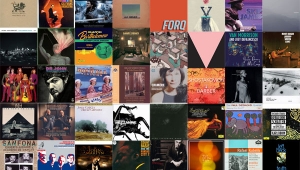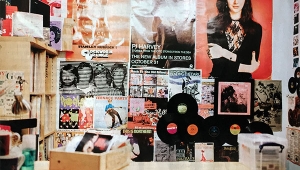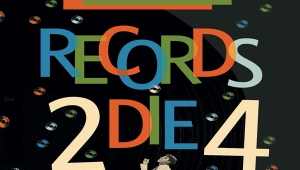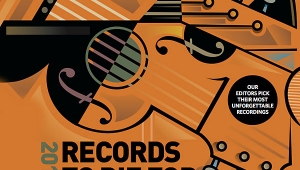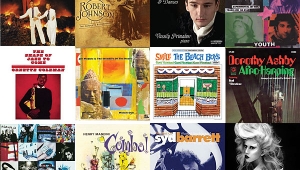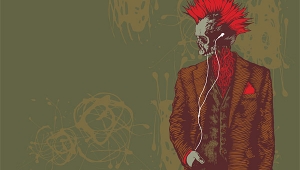| Columns Retired Columns & Blogs |
2004 Records To Die For Page 2
JOHN ATKINSON
GEOFF MULDAUR'S FUTURISTIC ENSEMBLE: Private Astronomy: A Vision of the Music of Bix Beiderbecke
DG Edge 028947458326 (CD). 2003. Dick Connette, prod.; Joe Boyd, exec. prod.; Eve Seltzer, Gary Carroll, Tristan Leral, Scott Lehrer, Dave Winslow, Mark Linett, Keith Weschler, Neil Couser, engs. AAD? TT: 42:18
Popular music is ephemeral by definition, anchored in the cultural and social values from which it emerged. Without reference to those values, it can be hard to understand what the fuss was about—unless the man or woman behind the music was a genius. Such was the case with cornetist Bix Beiderbecke, who drank himself to death in 1931: his haunting music should have been alienated by the intervening years yet seems familiar, even comfortable.
THE FUNK BROTHERS: Standing in the Shadows of Motown (Original Soundtrack)
Hip-O 440 064 691-2 (CD), Artisan 13780 1 (DVD-V, DVD-ROM). 2003. Allan Slutsky, Henry Weinger, Ted Greenberg, prods., except for: Holland, Lamont Dozier, prods., tracks 4, 10; Berry Gordy, Lawrence T. Horn, prods., track 15; Paul Elliott, David Scott, Pat Lawrence, exec. prods.; Kooster McAllister, eng.; Paul Prestopino, Marshall Fawcett, Chris Prinzivalli, asst. engs.; Kevin Reeves, mix, tracks 4, 10. ADD? TTs: 55:00 (CD), 110:00 (DVD-V).
"They played on more #1 records than the Beatles, the Beach Boys, the Rolling Stones and Elvis Presley combined...but no one knows their names" blares the blurb on the CD booklet's title page. But as a bass player, I had long been familiar with the name of one of the Funk Brothers, the Detroit session men who powered the inexorable rise of Motown in the 1960s: the late James Jamerson, the bass player's bass player. The seemingly endless stream of Motown hits had played a major role in the soundtrack to my adolescence, and I had eagerly obtained Allan "Dr. Licks" Slutsky's book of Jamerson transcriptions when it was published in 1988.
J.S. BACH: Goldberg Variations
Rosalyn Tureck, piano
Deutsche Grammophon 289 459 599-2 (2 CDs). 1999. Helmut Burk, prod.; Stefan Flock, eng. DDD. TT: 91:10
2003 was a big year for Bach in R2D4, with no fewer than five mentions. Three of those were for various recordings of the Goldberg Variations, including Glenn Gould's three-disc set, A State of Wonder. The title of that set is taken from a quotation: "The purpose of art," Gould said, "is not the release of a momentary ejection of adrenaline but rather the gradual, lifelong construction of a state of wonder and serenity." Rosalyn Tureck took a similar view: "I don't play this work as a tour de force," she wrote. "I play it as a life experience." But while Gould died young, Tureck lived and recorded well into her '80s—she died last July, at 88—and her last recording of the Goldbergs suggests that she managed to attain the "lifelong construction of a state of wonder and serenity" that Gould aspired to.
J.S. BACH: Brandenburg Concertos 1-6
Nikolaus Harnoncourt, Concentus Musicus Wien
Teldec 4509-95980-2 (2 CDs). 1983. Helmut Mühle, prod.; Michael Brammann, eng. DDD. TT: 2:27:39
There is, however, something to be said for adrenaline ejections, even in Bach. At the other end of the spectrum from Tureck's contemplative, modern-instrument Bach sit Harnoncourt's raucous Brandenburg Concertos, performed on period instruments. If you still think of classical music—and Bach in particular—as "pretty," buy this set and be disabused. It may have been written by a master of form, but the way Harnoncourt and his band play it, it's turn-of-the-18th-century party music. Check out the three-minute harpsichord riff in the first Allegro of No.5, or the driving bass of the No.6 Allegro. Though it shares some of modern music's rough edge and high-octane energy, this is the furthest thing from crossover music; it's ballsy, no-compromise, highbrow stuff. The real joy of this disc is in the real, vibrant sounds: resonant wood, scratchy gut, buzzing lips. This is 300-year-old punk. Turn it up.
FOUNTAINS OF WAYNE: Welcome Interstate Managers
S-Curve 5 90375 2 (CD). 2003. Chris Collingwood, prod.; Adam Schlesinger, Mike Denneen, prods., engs.; Richard Furch, Rudyard Lee Cullers, Matt Beaudoin, Rafi Sofer, engs. AAD. TT: 55:06
Every critic and serious music arguer alive overuses the "influenced by the Beatles" catch-all. When in doubt (the logic goes), always throw in "John and Paul" for gravitas. But then there are those albums where the feeling that John and Paul are hovering everywhere is inescapable. Welcome Interstate Managers is one of them.
CALEXICO: Feast of Wire
Quarterstick QS 78 (CD). 2003. Craig Schumacher, prod., eng.; Joey Burns, John Convertino, prods.; Nick Luca, eng. AAD? TT: 50:33
With Feast of Wire, Calexico, once a side project for Giant Sand drummer John Convertino and bassist Joey Burns, has turned serious and blossomed into its own full-fledged collective (like Giant Sand), full of ideas and promise. The vibe of what used to be an entirely instrumental project has always been spare eclecticism spiked with plenty of noise, exotic instruments, and experimentalism run rampant. These tracks, while still spare, conform to song structures and are better-recorded. There's also more drama these days, a better sense of allowing songs to build and expand.
PROKOFIEV: The Stone Flower
Gianandrea Noseda, BBC Philharmonic
Chandos CHAN 10058 (CD). 2003. Mike George, prod.; Stephen Rinker, eng. DDD. TT: 2:28:19
As a product of Prokofiev's final, fraught Soviet period, The Stone Flower may lack the rhythmic élan of his previous epic ballets, Romeo and Juliet and Cinderella; yet it remains a marvel of the composer's unique melodic and textural genius. After the early, now unavailable Melodiya recording, a German radio set on CPO reintroduced the complete score a few years ago. Raising the bar significantly, this Chandos version was by far the key new recording of the Prokofiev anniversary last year. Led by Milanese conductor Gianandrea Noseda (a protégé of Kirov icon Valery Gergiev), this richly recorded, marvelously vivid performance fulfills a Prokofievian's every wish.
TIM BERNE: Science Friction
Screwgun 013 (CD). 2002. David Torn, prod.; Tom Mark, eng. DDD. TT: 52:04
Beyond the questing spirit of alto saxophonist Tim Berne, the guiding force here is guitarist and loop guru David Torn. He "produced, manipulated, processed and complemented" Science Friction, which blasts forth from the virtual grooves like a mad-professor makeover of Ornette Coleman's Prime Time. The title pun is apt, as the sparks stem from the organic mastery of jazz rubbing up against the most forward-minded studio savvy. The electric improvisations of Berne, keyboardist Craig Taborn, drummer Tom Rainey, and French guitar provocateur Marc Ducret yielded the initial artifact. Strangely, Torn's digital derring-do not only took it totally out, but helped make it mesmerizing to the contemporary ear.
THE INCREDIBLE STRING BAND: Liquid Acrobat as Regards the Air
Sepia Tone STONE009 (CD). 1972/2002. Incredible String Band, prods.; Roger Mayer, eng. AAD. TT: 45:30
Robin Williamson, who is probably best known for the oft-recorded "First Girl I Loved," could have had a great career. Instead, he had four or five pretty good careers. The one exemplified by the Incredible String Band has, in the words of Midheaven Mailorder, "retained [a] loyal following of crackpot hippies and ethnomusicologists." Liquid Acrobat makes my list because of one remarkable track, the 10-minute "Darling Belle," a Great War tale of love and loss that continues to get me even after a thousand rehearings. I have heard scuttlebutt about a new reissue that will fix some of the sonic problems of the old version.
DAR WILLIAMS: Mortal City
Razor and Tie RT 2821-2 (CD) (1996). Steven Miller, prod., eng. DDD? TT: 46:50
The sound here is not as good as the justly praised audiophile issues of Dar Williams' first album, The Honesty Room. On reflection, however, the musical content here is even better! Williams has an extraordinary ability to tell a complex story in few words, depending on the force of what she omits rather than what she says. Combine this with her gift for melodies that complement instead of overpower, and you have everything this particular crackpot hippie ethnomusicologist could want. And while you're listening, give "This Was Pompeii" a couple of chances. It'll grow on you, guaranteed.
THE MONROE BROTHERS: What Would You Give in Exchange for Your Soul?
Charlie Monroe, vocals, guitar; Bill Monroe, vocals, mandolin Rounder 82161-1073-2 (CD). 1936/2000. Eli Oberstein, prod.; Jack Towers, Toby Mountain, remastering. AAD. TT: 41:09
The Blue Sky Boys' harmonies may have been silkier, but no other old-time country brother duet could match the blazing speed and sheer brilliance of the Monroe Brothers, Bill and Charlie, whose joint recording career lasted a mere two years before they split up in 1938. Charlie, the older brother, never had a hit on his own, while Bill went on to lasting fame as the father of bluegrass, named after his band, the Blue Grass Boys.
MAX ROACH TRIO: Featuring the Legendary Hasaan
Max Roach, drums; Hasaan Ibn Ali, piano; Art Davis, bass Atlantic 82273-2 (CD). 1965/1986 Arif Mardin, prod.; Tom Dowd, eng. AAD. TT: 41:05
Hasaan Ibn Ali, a jazz pianist from Philadelphia, made only one album, and it's a masterpiece. Recorded in late 1964, it falls between the stylistic cracks—not quite bebop, modal, or free jazz—in a way that makes it sound contemporary today. Hasaan was a disciple of Elmo Hope and, by extension, of Thelonious Monk, but his forcefully fractured figures on the seven original compositions here are distinctively his own. The only drawback, strangely enough, is Max Roach's loud and busy drumming, leaving "Hope So Elmo," on which Hasaan is accompanied only by Art Davis' arco bass, and "To Inscribe," a solo piano piece, as the most attractive cuts.
GEOFF MULDAUR'S FUTURISTIC ENSEMBLE: Private Astronomy: A Vision of the Music of Bix Beiderbecke
DG Edge 028947458326 (CD). 2003. Dick Connette, prod.; Joe Boyd, exec. prod.; Eve Seltzer, Gary Carroll, Tristan Leral, Scott Lehrer, Dave Winslow, Mark Linett, Keith Weschler, Neil Couser, engs. AAD? TT: 42:18
Popular music is ephemeral by definition, anchored in the cultural and social values from which it emerged. Without reference to those values, it can be hard to understand what the fuss was about—unless the man or woman behind the music was a genius. Such was the case with cornetist Bix Beiderbecke, who drank himself to death in 1931: his haunting music should have been alienated by the intervening years yet seems familiar, even comfortable.
I first heard a Beiderbecke composition—"In a Mist"—on Ry Cooder's 1978 album Jazz, one of my 1993 R2D4 picks. "In a Mist" appears twice on Private Astronomy, Stereophile's October 2003 "Recording of the Month." While Geoff Muldaur's arrangements are very different from Cooder's, being mainly for wind ensemble, he treats this music as Cooder did, with affection and respect, allowing it to speak for itself. Delicate the treatment may be, but that doesn't mean this acoustic music doesn't rock when required. Just put on track 3 and dig Martha Wainwright (sister of Rufus, daughter of Loudon and one of the McGarrigle sisters) cutting an incisive path through the slow drag of "There Ain't No Sweet Man (That's Worth the Salt in My Tears)": timeless stuff. (XXVI-10)
THE FUNK BROTHERS: Standing in the Shadows of Motown (Original Soundtrack)
Hip-O 440 064 691-2 (CD), Artisan 13780 1 (DVD-V, DVD-ROM). 2003. Allan Slutsky, Henry Weinger, Ted Greenberg, prods., except for: Holland, Lamont Dozier, prods., tracks 4, 10; Berry Gordy, Lawrence T. Horn, prods., track 15; Paul Elliott, David Scott, Pat Lawrence, exec. prods.; Kooster McAllister, eng.; Paul Prestopino, Marshall Fawcett, Chris Prinzivalli, asst. engs.; Kevin Reeves, mix, tracks 4, 10. ADD? TTs: 55:00 (CD), 110:00 (DVD-V).
"They played on more #1 records than the Beatles, the Beach Boys, the Rolling Stones and Elvis Presley combined...but no one knows their names" blares the blurb on the CD booklet's title page. But as a bass player, I had long been familiar with the name of one of the Funk Brothers, the Detroit session men who powered the inexorable rise of Motown in the 1960s: the late James Jamerson, the bass player's bass player. The seemingly endless stream of Motown hits had played a major role in the soundtrack to my adolescence, and I had eagerly obtained Allan "Dr. Licks" Slutsky's book of Jamerson transcriptions when it was published in 1988.
However, I had never imagined that one day not just a movie but a great movie would be produced documenting the story behind Motown's musical magic. (The DVD comes with a second disc repeating much of the movie in hi-def, playable on a PC with Windows Media Player 9.) But Standing in the Shadows of Motown is not just an exercise in nostalgia: the surviving Funk Brothers provide the fuel for great live performances of Motown classics by Joan Osborne, Bootsy Collins, Chaka Khan, Ben Harper, and others, with Tom Scott channeling Junior Walker's tenor sax on "Shotgun." The original backing track to the Supremes' "You Keep Me Hanging On" is a revelation, but the CD track to which I keep returning is the remix of "Bernadette," which starts with Jamerson's damped bass playing solo for a chorus and a verse. His fatback Fender continues to occupy the song's center stage as the rest of the Funk Brothers creep into the mix, until Levi Stubbs punctuates a sudden silence with a shouted-out "Bernadette," the only vocal part on the cut. Spine-tingling stuff.
JAMES AUSTIN
J.S. BACH: Goldberg Variations
Rosalyn Tureck, piano
Deutsche Grammophon 289 459 599-2 (2 CDs). 1999. Helmut Burk, prod.; Stefan Flock, eng. DDD. TT: 91:10
2003 was a big year for Bach in R2D4, with no fewer than five mentions. Three of those were for various recordings of the Goldberg Variations, including Glenn Gould's three-disc set, A State of Wonder. The title of that set is taken from a quotation: "The purpose of art," Gould said, "is not the release of a momentary ejection of adrenaline but rather the gradual, lifelong construction of a state of wonder and serenity." Rosalyn Tureck took a similar view: "I don't play this work as a tour de force," she wrote. "I play it as a life experience." But while Gould died young, Tureck lived and recorded well into her '80s—she died last July, at 88—and her last recording of the Goldbergs suggests that she managed to attain the "lifelong construction of a state of wonder and serenity" that Gould aspired to.
J.S. BACH: Brandenburg Concertos 1-6
Nikolaus Harnoncourt, Concentus Musicus Wien
Teldec 4509-95980-2 (2 CDs). 1983. Helmut Mühle, prod.; Michael Brammann, eng. DDD. TT: 2:27:39
There is, however, something to be said for adrenaline ejections, even in Bach. At the other end of the spectrum from Tureck's contemplative, modern-instrument Bach sit Harnoncourt's raucous Brandenburg Concertos, performed on period instruments. If you still think of classical music—and Bach in particular—as "pretty," buy this set and be disabused. It may have been written by a master of form, but the way Harnoncourt and his band play it, it's turn-of-the-18th-century party music. Check out the three-minute harpsichord riff in the first Allegro of No.5, or the driving bass of the No.6 Allegro. Though it shares some of modern music's rough edge and high-octane energy, this is the furthest thing from crossover music; it's ballsy, no-compromise, highbrow stuff. The real joy of this disc is in the real, vibrant sounds: resonant wood, scratchy gut, buzzing lips. This is 300-year-old punk. Turn it up.
ROBERT BAIRD
FOUNTAINS OF WAYNE: Welcome Interstate Managers
S-Curve 5 90375 2 (CD). 2003. Chris Collingwood, prod.; Adam Schlesinger, Mike Denneen, prods., engs.; Richard Furch, Rudyard Lee Cullers, Matt Beaudoin, Rafi Sofer, engs. AAD. TT: 55:06
Every critic and serious music arguer alive overuses the "influenced by the Beatles" catch-all. When in doubt (the logic goes), always throw in "John and Paul" for gravitas. But then there are those albums where the feeling that John and Paul are hovering everywhere is inescapable. Welcome Interstate Managers is one of them.
Given that their name comes from a lawn-fountain store in northern New Jersey, it's no big surprise that FoW come from the same North Jersey brainiac pop lineage as The Feelies and Yo La Tengo. But here, on their third record, they've risen above their roots, written a bunch of tunes that could all be killer singles, and become one of the great pop bands of this or any other era.
The "I Want to Hold Your Hand" teeny love anthem gloriously reappears here in the still-rising-as-I-wrote-this single, "Stacy's Mom" ("has got it going on..."). The cheeky wall-o'-guitar opener, "Mexican Wine," works the loud/soft dynamic to perfection, the perky, Latin-tinged "Hey Julie" is irresistible, and "Hung Up On You," the band's honky-tonk homage, is a howl.
Much of the genius here is in the details. There's the plunky, doleful guitar tone of "Hackensack," the familiar (ie, Beatlesesque) upward vocal trill in the verses of the glistening "All Kinds of Time," and the moody, acoustic setting, piano chords, and chicka-chicka-chicka soul-guitar scratch of "Halley's Waitress"—all of which make this the kind of smart, animated, scampish pop record that many have attempted but few can master. (XXVI-10)
CALEXICO: Feast of Wire
Quarterstick QS 78 (CD). 2003. Craig Schumacher, prod., eng.; Joey Burns, John Convertino, prods.; Nick Luca, eng. AAD? TT: 50:33
With Feast of Wire, Calexico, once a side project for Giant Sand drummer John Convertino and bassist Joey Burns, has turned serious and blossomed into its own full-fledged collective (like Giant Sand), full of ideas and promise. The vibe of what used to be an entirely instrumental project has always been spare eclecticism spiked with plenty of noise, exotic instruments, and experimentalism run rampant. These tracks, while still spare, conform to song structures and are better-recorded. There's also more drama these days, a better sense of allowing songs to build and expand.
These seemingly disparate elements come together to great effect in the instrumental "Close Behind," where insistently strummed Norte;tno guitars meet pedal steel guitar, violin overdubs, and the kind of galloping chorus TV cop shows like Hawaii Five-O have always employed. The next tune, "Woven Birds," has an ascending chorus in which the vocals are accompanied by orchestral bells and clusters of stringed instruments. "Whipping the Horse's Eyes," a short duet between pedal steel and cello, is a striking interlude, and "Crumble," with its interplay of muted trumpets and trumpet solos, is jazz. And "Across the Wire" with its mariachi trumpets, strummed guitar, and button accordion, embodies the flavor of the band's home town of Tucson, Arizona.
While-Giant-Sand-Is-On-Hiatus Runner-Up: 2003's Still Lookin' Good to Me, by The Band of Blacky Ranchette. (XXVI-4)
BRADLEY BAMBARGER
PROKOFIEV: The Stone Flower
Gianandrea Noseda, BBC Philharmonic
Chandos CHAN 10058 (CD). 2003. Mike George, prod.; Stephen Rinker, eng. DDD. TT: 2:28:19
As a product of Prokofiev's final, fraught Soviet period, The Stone Flower may lack the rhythmic élan of his previous epic ballets, Romeo and Juliet and Cinderella; yet it remains a marvel of the composer's unique melodic and textural genius. After the early, now unavailable Melodiya recording, a German radio set on CPO reintroduced the complete score a few years ago. Raising the bar significantly, this Chandos version was by far the key new recording of the Prokofiev anniversary last year. Led by Milanese conductor Gianandrea Noseda (a protégé of Kirov icon Valery Gergiev), this richly recorded, marvelously vivid performance fulfills a Prokofievian's every wish.
TIM BERNE: Science Friction
Screwgun 013 (CD). 2002. David Torn, prod.; Tom Mark, eng. DDD. TT: 52:04
Beyond the questing spirit of alto saxophonist Tim Berne, the guiding force here is guitarist and loop guru David Torn. He "produced, manipulated, processed and complemented" Science Friction, which blasts forth from the virtual grooves like a mad-professor makeover of Ornette Coleman's Prime Time. The title pun is apt, as the sparks stem from the organic mastery of jazz rubbing up against the most forward-minded studio savvy. The electric improvisations of Berne, keyboardist Craig Taborn, drummer Tom Rainey, and French guitar provocateur Marc Ducret yielded the initial artifact. Strangely, Torn's digital derring-do not only took it totally out, but helped make it mesmerizing to the contemporary ear.
LES BERKLEY
THE INCREDIBLE STRING BAND: Liquid Acrobat as Regards the Air
Sepia Tone STONE009 (CD). 1972/2002. Incredible String Band, prods.; Roger Mayer, eng. AAD. TT: 45:30
Robin Williamson, who is probably best known for the oft-recorded "First Girl I Loved," could have had a great career. Instead, he had four or five pretty good careers. The one exemplified by the Incredible String Band has, in the words of Midheaven Mailorder, "retained [a] loyal following of crackpot hippies and ethnomusicologists." Liquid Acrobat makes my list because of one remarkable track, the 10-minute "Darling Belle," a Great War tale of love and loss that continues to get me even after a thousand rehearings. I have heard scuttlebutt about a new reissue that will fix some of the sonic problems of the old version.
DAR WILLIAMS: Mortal City
Razor and Tie RT 2821-2 (CD) (1996). Steven Miller, prod., eng. DDD? TT: 46:50
The sound here is not as good as the justly praised audiophile issues of Dar Williams' first album, The Honesty Room. On reflection, however, the musical content here is even better! Williams has an extraordinary ability to tell a complex story in few words, depending on the force of what she omits rather than what she says. Combine this with her gift for melodies that complement instead of overpower, and you have everything this particular crackpot hippie ethnomusicologist could want. And while you're listening, give "This Was Pompeii" a couple of chances. It'll grow on you, guaranteed.
LARRY BIRNBAUM
THE MONROE BROTHERS: What Would You Give in Exchange for Your Soul?
Charlie Monroe, vocals, guitar; Bill Monroe, vocals, mandolin Rounder 82161-1073-2 (CD). 1936/2000. Eli Oberstein, prod.; Jack Towers, Toby Mountain, remastering. AAD. TT: 41:09
The Blue Sky Boys' harmonies may have been silkier, but no other old-time country brother duet could match the blazing speed and sheer brilliance of the Monroe Brothers, Bill and Charlie, whose joint recording career lasted a mere two years before they split up in 1938. Charlie, the older brother, never had a hit on his own, while Bill went on to lasting fame as the father of bluegrass, named after his band, the Blue Grass Boys.
This album features the brothers' earliest recordings, drawn from two 1936 sessions. The title track, a dour but mellifluous hymn in waltz time, was their first release and first big hit. Not until their third record—"My Long Journey Home," b/w the classic "Nine Pound Hammer"—could Bill's mind-boggling mandolin be heard at full tilt. Some of the religious songs, especially "This World Is Not My Home" and the scolding "Do You Call That Religion?," are irresistible in their sweet sorrow, but it's cranked-up folksongs like "New River Train" and "Watermelon Hangin' on That Vine" that take your breath away.
MAX ROACH TRIO: Featuring the Legendary Hasaan
Max Roach, drums; Hasaan Ibn Ali, piano; Art Davis, bass Atlantic 82273-2 (CD). 1965/1986 Arif Mardin, prod.; Tom Dowd, eng. AAD. TT: 41:05
Hasaan Ibn Ali, a jazz pianist from Philadelphia, made only one album, and it's a masterpiece. Recorded in late 1964, it falls between the stylistic cracks—not quite bebop, modal, or free jazz—in a way that makes it sound contemporary today. Hasaan was a disciple of Elmo Hope and, by extension, of Thelonious Monk, but his forcefully fractured figures on the seven original compositions here are distinctively his own. The only drawback, strangely enough, is Max Roach's loud and busy drumming, leaving "Hope So Elmo," on which Hasaan is accompanied only by Art Davis' arco bass, and "To Inscribe," a solo piano piece, as the most attractive cuts.
The original Atlantic CD of The Max Roach Trio Featuring the Legendary Hasaan, a facsimile of the original 1965 LP, gives its release date as 1966, which is obviously impossible because there were no CDs then. That CD, as reviewed above, is out of print, but the album is currently available as part of the 1999 Max Roach CD Featuring the Legendary Hasaan/Drums Unlimited (Collectibles Jazz Classics 6256), which couples the complete Hasaan album with Roach's Drums Unlimited, originally released in 1966.
- Log in or register to post comments





